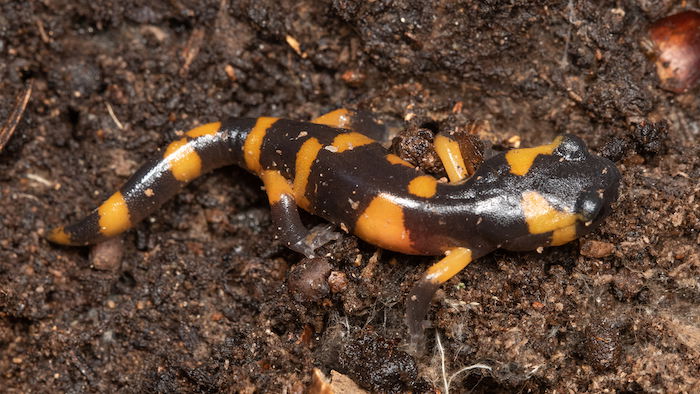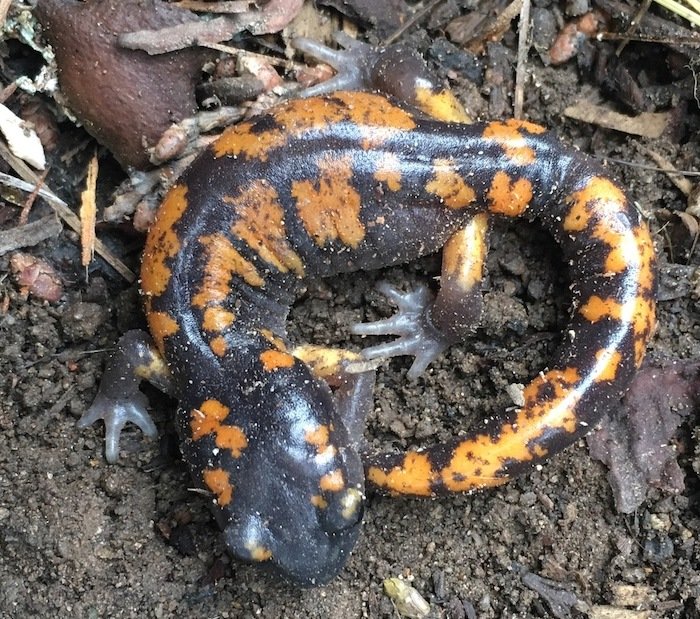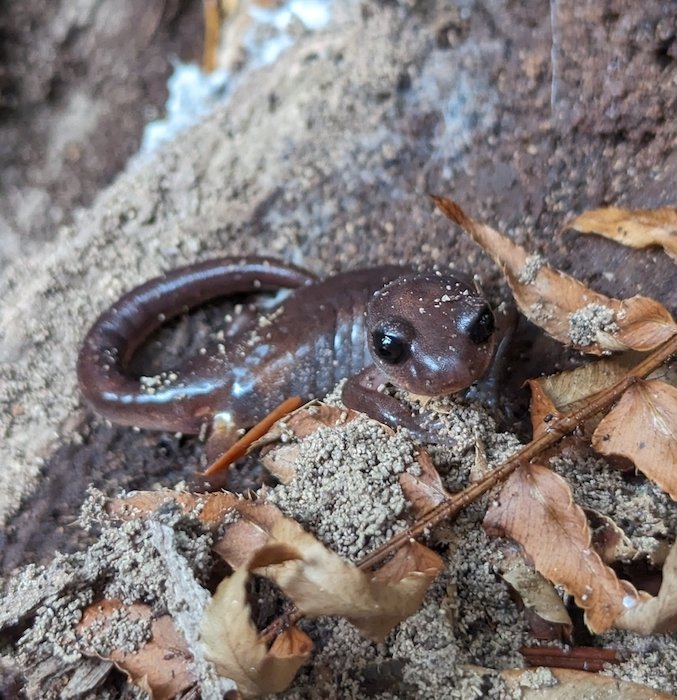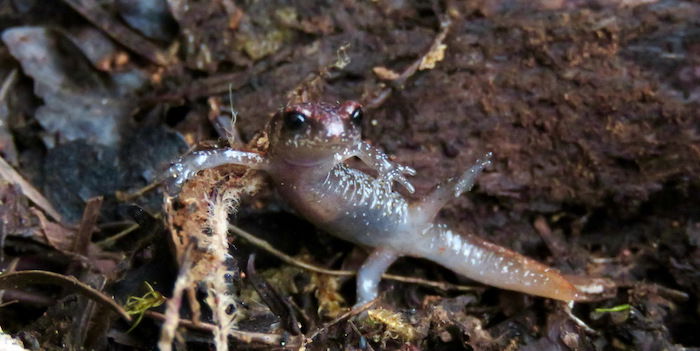Poisonous Pretender
Ensatina by aromatisse, CC BY 4.0, via iNaturalist
Ensatina
by Inspector Barry Mins on March 12, 2024Hey kids, welcome back to our series on the mysteries of created kinds.
Last week, we met a group of small Australasian birds. This week, we come back to the western edge of North America looking for even smaller quarry: salamanders. Fortunately, they are colorful, so they should be relatively easy to find.

It is unclear exactly how many species are in this kind (we’ll get to why later). It is composed of a single genus that lives as far north as British Columbia, Canada, and as far south as Baja California in Mexico. Some of the members of this kind exhibit something called aposematic coloration.1 This means that they have bright colors that mimic a poisonous species. They are not poisonous themselves, but their predators do not know that and stay far away from the bright colors. These little salamanders are predators themselves, munching on small insects and insect larva.2 For small animals, they get around. One study estimated they regularly travel distances of more than 32 feet.3 That may not seem like much to you, but when you’re a tiny salamander who covers only an inch or two per step, that’s a long trip!
The courtship between males and females is ornate and complex. The males initiate, rubbing the female’s sides to induce her to follow him, before mating takes place.4 When these salamanders mate, they build nests relatively close to water and under fallen wood.5 This makes sense since one of this kind’s favorite foods is termites, and termites love rotten wood.
Now, there is a very interesting thing going on with this kind. Its members are in something called a ring species.6 A ring species is a group of subspecies that can breed with each other where their ranges overlap, but the species at the ends of the ring do not interbreed. Many of the subspecies in this kind will breed with each other and their hybrids often result from mating between females of one subspecies and males of another.7
Has anyone figured it out yet? This week’s kind is the Ensatina—the ensatina salamander kind. Stay tuned for next week when we head north looking for a waterfowl best known for its haunting call.
Try out this fun crossword!
Clue
Your clue for the week is:
This bird lends its common name to a synonym of crazy, a word that was also used as the title for a popular kids cartoon.
Ask a Question
Have you ever had a question about created kinds but didn’t know who to ask? Have you ever wanted to learn more about your favorite kind? Well, now you can! You can ask me, Inspector Barry Mins, a question! Have your parents help you fill out this form, and you might get your question answered in my column! If you have any questions about created kinds, feel free to send them my way!
Footnotes
- Shawn R. Kuchta, “Experimental Support for Aposematic Coloration in the Salamander Ensatina eschscholtzii xanthoptica: Implications for Mimicry of Pacific Newts,” Copeia 2 (2005): 265–271, http://www.stevenpoe.net/uploads/3/7/3/4/37343605/2005_kuchta_copeia.pdf.
- Stephen M. Deban, “Modulation of Prey-Capture Behavior in the Plethodontid Salamander Ensatina eschscholtzii,” The Journal of Experimental Biology 200, no. 14 (1997): 1951–1964, https://www.researchgate.net/profile/Stephen-Deban/publication/13904715_Modulation_of_prey-capture_behavior_in_the_plethodontid_salamander_Ensatina_Eschscholtzii/links/00b7d527cda831441e000000/Modulation-of-Prey-Capture-Behavior-in-the-Plethodontid-Salamander-Ensatina-Eschscholtzii.pdf.
- Nancy L. Staub, Charles W. Brown, and David B. Wake, “Patterns of Growth and Movements in a Population of Ensatina eschscholtzii platensis (Caudata: Plethodontidae) in the Sierra Nevada, California,” Journal of Herpetology 29, no. 4 (1995): 593–599, https://www.researchgate.net/profile/Nancy-Staub/publication/272529880_Patterns_of_Growth_and_Movements_in_a_Population_of_Ensatina_eschscholtzii_platensis_Caudata_Plethodontidae_in_the_Sierra_Nevada_California/links/5773fc8908ae4645d60a0acb/Patterns-of-Growth-and-Movements-in-a-Population-of-Ensatina-eschscholtzii-platensis-Caudata-Plethodontidae-in-the-Sierra-Nevada-California.pdf.
- Robert C. Stebbins, “Courtship of the Plethodontid Salamander Ensatina eschscholtzii,” Copeia 1949, no. 4 (1949): 274–281, https://www.jstor.org/stable/1438380.
- Deanna H. Olson, Richard S. Nauman, Loretta L. Ellenburg, Bruce P. Hansen, and Samuel S. Chan, “Ensatina eschscholtzii Nests at a Managed Forest Site in Oregon,” Northwestern Naturalist 87 (2006): 203–208, https://andrewsforest.oregonstate.edu/sites/default/files/lter/pubs/pdf/pub4191.pdf.
- Shawn R. Kuchta, Duncan S. Parks, Rachel Lockridge Mueller, and David B. Wake, “Closing the Ring: Historical Biogeography of the Salamander Ring Species Ensatina eschscholtzii,” Journal of Biogeography 36 (2009): 982–995, https://citeseerx.ist.psu.edu/document?repid=rep1&type=pdf&doi=11f066afc3b7dc2daea079ce04c15ab3f6964bea.
- Thomas J. Devitt, Stuart J. E. Baird, and Craig Moritz, “Asymmetric Reproductive Isolation Between Terminal Forms of the Salamander Ring Species Ensatina eschscholtzii Revealed by Fine-Scale Genetic Analysis of a Hybrid Zone,” BMC Evolutionary Biology 11, no. 245 (2011): https://link.springer.com/article/10.1186/1471-2148-11-245.
- © 2024 Answers in Genesis
- Privacy Policy
- Contact
- About





